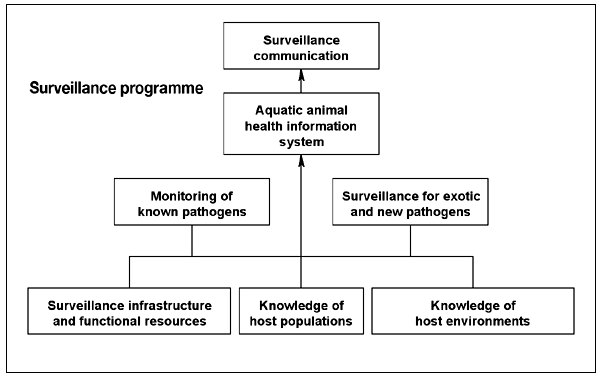“The primary purpose of aquatic animal disease surveillance is to provide cost-effective information for assessing and managing risks associated with trade (intra- and international) in aquatic animals and products, animal production efficiency and public health.” (FAO, 2004)
Disease surveillance is an underpinning necessity for any effective government aquatic animal health protection programme. This maximizes the chances of early detection of diseases of concern and provides the data required for science-based certification of export health status, international reporting and verification of freedom from diseases. A comprehensive disease surveillance system provides a reliable picture of the health status of aquatic animal populations on an ongoing basis. It also provides the tracking/traceability information for rapid and effective response to the emergence of an aquatic animal disease emergency.
Figure 3 provides a conceptual summary of the relationships among the broad components of a national aquatic animal disease surveillance programme. This figure incorporates the concepts of the OIE Aquatic Animal Health Code of providing an effective surveillance infrastructure, as well as including a description of host population and environmental characteristics. Detailed guidance to Responsible Authorities for establishing a national system for surveillance and zoning for aquatic animal diseases can be found in Surveillance and Zoning for Aquatic Animal Diseases (FAO, 2004). An important concept for contingency planning in relation to surveillance and zoning is planning for a disease emergency in vulnerable resources than span national borders (shared waters). Collaborative surveillance and zoning, as well as contingency planning, is essential to prevent one country’s efforts, or lack thereof, affecting their neighbour’s efforts.
FIGURE 3
Relationships among different components of a surveillance programme incorporating
OIE Code concepts
(Baldock, 2005)

Information on aquatic animal diseases important to the Asia-Pacific Region can be found in the OIE Aquatic Animal Health Code and Manual of Diagnostic Tests for Aquatic Animals (OIE, 2003, 2004), the Asia Diagnostic Guide to Aquatic Animal Diseases (FAO/NACA, 2001), the Network of Aquaculture Centres in Asia-Pacific (NACA)/Food and Agriculture Organization of the United Nations (FAO)/OIE Quarterly Aquatic Animal Disease Reporting System (http://www.enaca.org/Health/QAAD) and the OIE International Database on Aquatic Animal Diseases (http://www.collabcen.net). The current status of serious diseases of aquatic animals in the Asia-Pacific Region has recently been reviewed by Arthur (2005).